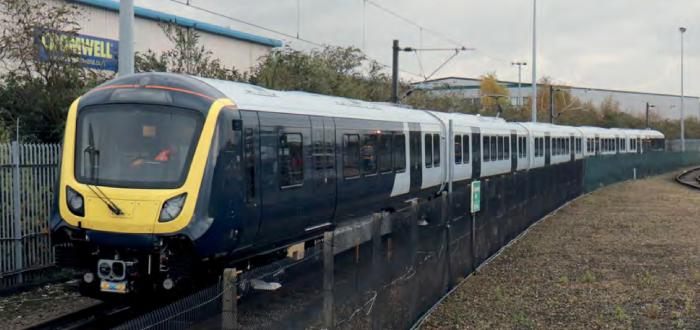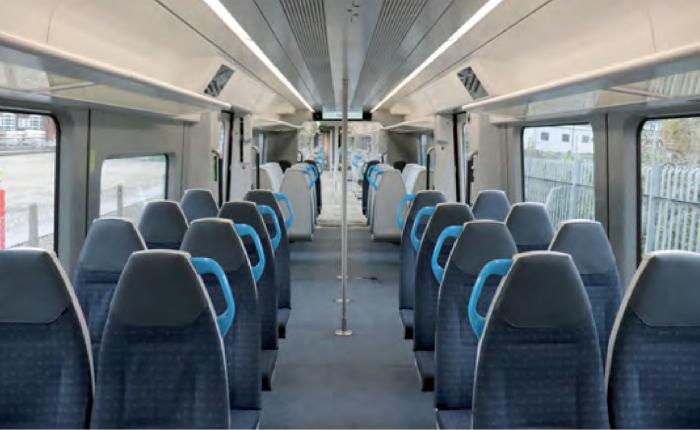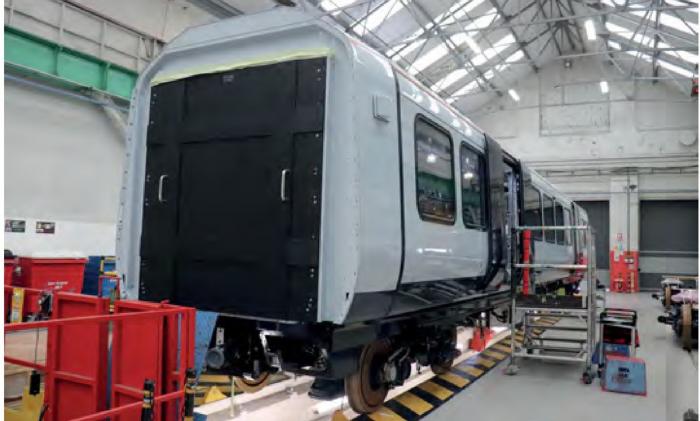NEW SUBURBAN FLEET TO ENTER SERVICE FROM MID-2020
SOUTH WESTERN Railway has showcased the first of its Class 701 Aventra EMUs ordered from Bombardier for suburban services into Waterloo.
SWR has ordered 60x10-car and 30x5-car units from Bombardier, financed by Rock Rail. As of mid-November the first three trains (two five-car and one 10-car) had been completed, with the second 10-car unit on the production line. Bombardier is converting a second production line over to ‘701s’ with a third due to follow in the New Year; each is capable of producing four vehicles a week.
The first four trains have been built for type testing, with No 701501 shipped out to the Velim test circuit in the Czech Republic in the second half of November and No 701502 to be tested at Old Dalby. Only one unit is planned to be sent to Velim as it stands, although this may be reviewed if required. The first three trains are being built with dual-voltage capability for test purposes, but the pantographs will be removed once this phase has been completed.

READING LINE FIRST
The first train to be delivered to SWR will be Train 5, the first series production unit, which is planned to move south early in the New Year. Entry into passenger service is planned for mid-2020, with current plans seeing the first ‘701s’ entering service on the Reading line, this being dictated by crew training and route acceptance requirements. A 12-month introduction programme is due to see the full fleet in service by mid-2021; this has been accelerated from the 17 months originally planned, in part to catch up with delays which have resulted from the software problems facing earlier Aventra builds. Delivery of 10-car sets will be prioritised in order to provide the maximum capacity benefit as soon as possible, with the five-car sets requiring additional software functionality around multiple working and additional crew training for coupling and uncoupling of units.

Compared to previous Aventra builds the ‘701s’ have a flatter cab, which means doors will always be in the same place on the same platform whether a service is formed of a 10-car set or two five-cars coupled together. The ‘701s’ also employ ABDO (automatic braking and door opening) technology to help reduce dwell times at stations.
On-board facilities include free Wi-Fi, power and USB sockets at each pair of seats, air conditioning and real-time passenger information screens. Accessible toilets are provided on all trains, with one on a five-car unit and two on a 10-car set. Bio-reactor toilets are being installed rather than the more common controlled emission toilet (CET) with tanks, the bio-reactors having reduced requirements for emptying compared to CETs and discharging only ‘grey’ water to the track. Of the four fleets the ‘701s’ are replacing, only the Class 458s have toilets.
AVENTRA PRODUCTION
Following a series of software-related delays affecting its Aventras, Bombardier is looking to catch up by accelerating production and delivery of future builds.
Bombardier has six Aventra production lines at its Litchurch Lane factory – three in U shop and three in G shop, producing up to 24 vehicles a week in total. In U shop are the two SWR lines plus a third completing the Class 710 build for London Overground, which will switch to Class 701 production. In G shop are two lines building Class 720s for Greater Anglia and a third starting the construction of Class 730s for West Midlands Trains. The build of Class 345s for Crossrail is virtually complete, with last in class unit No 345070 in the V shop static test facility in mid-November. Class 720 production is due to finish at the back end of 2020, after which SWR’s ‘701s’ will for a short period occupy all six production lines prior to the end of construction in early 2021. The final Aventra order, of Class 711s for c2c, follows on from the ‘720’ build.

MAINTAINED AT WIMBLEDON
The ‘701’ fleet will be maintained at Wimbledon depot by SWR with support from Bombardier. As the depot’s facilities such as the wheel lathe and bogie drop are designed to maintain five-car sets, each 10-car unit will be capable of being split into two five-car sub-units within the depot. SWR is also building a new stabling facility at Feltham capable of accommodating 10x10-car ‘701s’ which is due to be completed in late 2020, and some ‘701s’ will also berth in sidings being built at Farnham. A particular risk for SWR is stabling capacity during the transition between old and new stock, with the operator working with Network Rail to assess requirements.
The ‘701s’ will replace all Class 455, 456, 458 and 707 units on suburban services across south west London, extending as far as Guildford and Reading. SWR’s original franchise plans envisaged handing back the four classes in reverse order of age, beginning with the newest type, the Class 707s. This is thought to have been a Department for Transport specification with a potential future transfer of the ‘707s’ to the South Eastern franchise in mind, but with this competition now cancelled and the future uncertain SWR is looking to hand back the ‘707s’ last and return older Class 455 and 456 units first; the ‘707’ lease was due to expire at the end of 2019 but SWR has an agreement with owner Angel Trains to extend this as required. With the accelerated schedule seeing 20 ‘701’ vehicles delivered each week, SWR will be required to withdraw as many as six trains of Classes 455 and 456 a week.
CLASS 701 SPECIFICATION
Designation Class 701/0 (10-car) – numbers 701001-060; Class 701/5 (five-car) – numbers 701501-530
Capacity ‘701/0’: 556 seated, 746 standing; 701/5’: 274 seated, 361 standing
Maximum speed 100mph
Acceleration 0.7m/s2
Deceleration 0.9m/s2 (maximum service brake)
Power supply 750V DC with fixed shoegear (three dual-voltage units for test purposes with retractable shoegear)
Doors Two sliding plug per vehicle side at one-third and two-thirds positions
Traction 40% motorisation 2,000A current limit per five-car (4,000A per 10-car) Through DC busline per five-car traction system
Regenerative braking, supplemented by rheostatic from roof-mounted brake resistors, and friction braking
